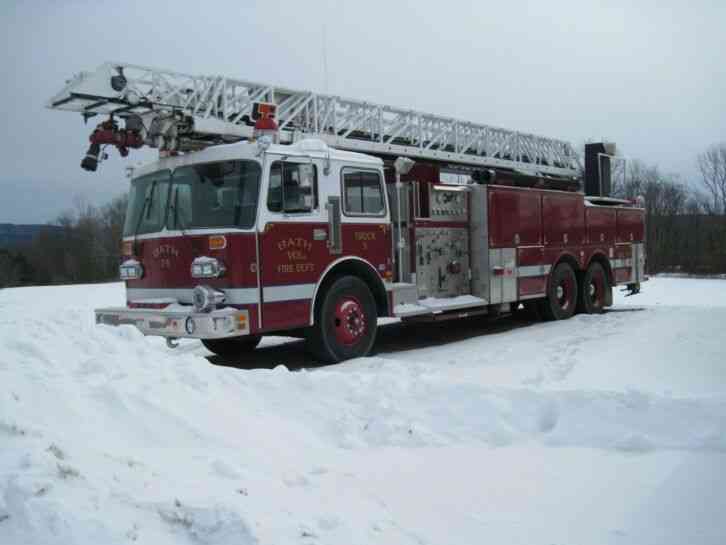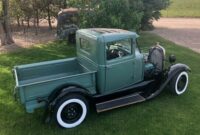Ladder Trucks For Sale: A Comprehensive Buyer’s Guide pickup.truckstrend.com
Introduction
In the critical world of emergency services, a ladder truck is more than just a vehicle; it’s a multi-functional apparatus, a lifeline, and a symbol of readiness. These formidable machines are indispensable for fire suppression, rescue operations, and providing elevated access in challenging environments. For fire departments, industrial facilities, and even some specialized construction firms, the acquisition of a ladder truck is a significant investment. Whether a department is expanding its fleet, replacing an aging apparatus, or seeking to enhance its capabilities on a budget, the market for "Ladder Trucks For Sale" offers a diverse range of options. This comprehensive guide aims to illuminate the intricacies of purchasing a ladder truck, providing insights into types, considerations, acquisition processes, and what to expect when navigating this specialized market.
Ladder Trucks For Sale: A Comprehensive Buyer’s Guide
What is a Ladder Truck? Understanding the Core Apparatus
A ladder truck, often referred to as an aerial apparatus, is a specialized fire fighting vehicle equipped with a large, extendable ladder or boom. Its primary functions include providing elevated water streams, facilitating high-angle rescue, offering access to upper floors of structures, and supporting ventilation efforts. While the term "ladder truck" is broadly used, the market for "Ladder Trucks For Sale" encompasses several distinct types, each designed for specific operational needs:
- Aerial Ladder Truck (Straight Stick): These are equipped with a single, telescoping ladder, typically ranging from 75 to 100 feet. They are excellent for reaching heights and providing elevated master streams.
- Platform Truck (Tower Ladder): Instead of just a ladder, these apparatus feature a large, enclosed platform (bucket) at the end of the aerial device. Platforms offer a safer and more stable working environment for firefighters, making them ideal for complex rescues, ventilation, and sustained elevated operations. They often range from 85 to 137 feet in height.
- Quint Apparatus: The term "Quint" is derived from its five primary functions: pump, water tank, hose, aerial device, and ground ladders. A quint combines the capabilities of a pumper and a ladder truck into one unit, offering versatility for departments with limited budgets or personnel.
- Tiller Truck (Tractor-Drawn Aerial – TDA): These distinctive trucks consist of two separate sections: a tractor that pulls a trailer, with the aerial ladder mounted on the trailer. A separate driver (the "tiller operator") steers the rear wheels, allowing for exceptional maneuverability in tight urban environments. Tiller ladders often extend to 100 feet or more.

Understanding these distinctions is crucial when searching for "Ladder Trucks For Sale," as each type serves different strategic purposes for a fire department.
Why Buy a Used Ladder Truck? Benefits and Considerations
While new ladder trucks boast the latest technology and zero mileage, the market for "Ladder Trucks For Sale" heavily features pre-owned apparatus, and for good reason. Purchasing a used ladder truck offers significant advantages, particularly for volunteer fire departments, smaller municipal fire departments, or those operating under strict budget constraints.
- Cost Savings: This is often the primary driver. A new ladder truck can cost anywhere from $1 million to $1.5 million or more. A well-maintained used apparatus can be acquired for a fraction of that price, often ranging from $150,000 to $700,000 depending on age, condition, and features.
- Immediate Availability: New apparatus often have lead times of 18-36 months due to manufacturing schedules. Used ladder trucks are typically available for immediate purchase and deployment, crucial for departments with urgent needs.
- Proven Reliability: A truck that has been in service for several years has likely had its initial kinks worked out. With proper maintenance records, you can assess its operational history and reliability.
- Reduced Depreciation: The steepest depreciation curve for any vehicle occurs in its first few years. Buying used means avoiding this initial, rapid loss of value.
- Customization Potential: Purchasing a used chassis can sometimes allow for more budget to be allocated towards custom modifications or new equipment integration, tailoring the truck to specific departmental needs.


However, buying used also requires diligent due diligence. Without proper inspection and understanding of its history, a seemingly good deal can quickly turn into a costly liability.
Key Considerations When Evaluating Ladder Trucks For Sale
When perusing listings for "Ladder Trucks For Sale," a meticulous evaluation process is paramount. Overlooking critical details can lead to unexpected expenses and operational inefficiencies.
- Age and Mileage/Hours: While a general indicator, these metrics need context. A 15-year-old truck with low mileage but high pump/aerial hours might indicate significant stationary operation. Conversely, a truck with higher mileage might suggest more road time but less wear on specialized equipment.
- Maintenance Records: This is arguably the most important factor. Comprehensive service records will reveal the truck’s history, including routine maintenance, repairs, parts replacements, and any recurring issues. Look for evidence of regular oil changes, fluid checks, brake service, and aerial lubrication.
- Pump Test Certification: If the truck is a quint or has a pump, ensure it has a valid annual pump test certification (e.g., NFPA 1911 compliant). This verifies the pump’s capacity and integrity.
- Aerial Device Certification: The aerial ladder or platform must undergo annual structural integrity and operational tests (e.g., NFPA 1911, OSHA standards). A valid certification is non-negotiable for safety.
- Chassis and Engine Condition: Inspect for rust, especially on the frame rails, suspension components, and cab. Check the engine for leaks, unusual noises, and proper fluid levels. Verify transmission fluid condition and shifting smoothness.
- Aerial Device Integrity: Look for cracks, dents, or signs of stress on the ladder sections, turntable, and outriggers. Test all aerial functions (extension, rotation, elevation, outrigger deployment) thoroughly.
- Ground Ladders and Equipment: Confirm that all required ground ladders are present, in good condition, and meet NFPA standards. Check other included equipment like breathing apparatus, generators, and lighting.
- Compartment Space and Layout: Assess if the existing compartmentation meets your department’s equipment storage needs or if modifications will be necessary.
- Electrical System: Test all lights, sirens, emergency warning systems, and on-board power outlets. Verify the generator’s functionality and output.
- Tires and Brakes: Examine tire tread depth, age, and signs of dry rot. Check brake pads, rotors, and air system components for wear.
- Safety Features: Ensure all safety interlocks, emergency stop buttons, and warning systems are fully functional.
Where to Find Ladder Trucks For Sale
The market for "Ladder Trucks For Sale" is diverse, with several avenues for sourcing apparatus:
- Specialized Fire Apparatus Dealers: These dealerships often have a wide inventory of new and used trucks, offering reconditioning services, warranties, and financing options. They typically have experienced sales staff who can guide you.
- Online Marketplaces: Websites like Fire Apparatus & Equipment, Fire Department Exchange (FDX), and Government Surplus Auctions often list trucks directly from departments or smaller dealers.
- Auctions: Government surplus auctions or specialized heavy equipment auctions can be a source of good deals, though "as-is, where-is" conditions require heightened caution and thorough pre-inspection.
- Direct from Fire Departments: Some departments sell their apparatus directly when upgrading. This can be found through word-of-mouth, regional fire service publications, or department websites.
- Brokerage Services: Brokers specialize in connecting buyers with sellers, often having access to apparatus not publicly listed.
The Essential Inspection Process
Once you’ve identified a promising "Ladder Truck For Sale," a comprehensive inspection is non-negotiable. Ideally, this should involve a qualified third-party mechanic specializing in heavy trucks and an aerial technician certified to inspect fire apparatus.
- Initial Visual Walk-Around: Look for obvious damage, rust, fluid leaks, and general condition.
- Chassis and Drivetrain Inspection:
- Engine: Start cold, listen for unusual noises, check exhaust smoke, look for leaks.
- Transmission: Test all gears, check for smooth shifting, look for leaks.
- Brakes: Check air pressure build-up, test service and parking brakes.
- Suspension: Look for worn components, sagging, or damage.
- Tires: Check age (DOT date code), tread, and condition.
- Aerial Device Inspection:
- Operate all functions (extension, retraction, elevation, rotation, outriggers) from both the turntable and bucket controls.
- Listen for unusual noises, look for excessive sway or shuddering.
- Inspect all welds, pins, cables, and hydraulic lines for wear, leaks, or damage.
- Verify the smooth operation of interlocks and safety systems.
- Pump (if applicable) and Water System Inspection:
- Perform a pump test if possible, or review recent test results.
- Inspect all gauges, valves, and piping for leaks or corrosion.
- Check the water tank for integrity.
- Electrical System and Lighting: Test all interior and exterior lights, warning lights, siren, and communication systems. Verify generator operation and power output.
- Interior Cab Inspection: Check for wear and tear, functionality of controls, and overall cleanliness.
- Documentation Review: Cross-reference VIN, engine hours, and mileage with maintenance records. Verify all certifications are current.
Financing Your Ladder Truck Purchase
Securing financing for "Ladder Trucks For Sale" is a critical step, especially for budget-conscious entities.
- Traditional Bank Loans: Many banks offer municipal or commercial vehicle loans.
- Leasing Programs: Operating leases or capital leases can offer lower upfront costs and flexible payment structures.
- Manufacturer/Dealer Financing: Some apparatus manufacturers or large dealers have their own financing arms.
- Grants: Various federal (e.g., AFG – Assistance to Firefighters Grant), state, and local grants are available to fire departments for apparatus acquisition. These are highly competitive but can significantly offset costs.
- Fundraising: For smaller or volunteer departments, community fundraising remains a vital source of capital.
Navigating the Purchase Process
The process of buying a used ladder truck, whether from a dealer or directly from a department, typically involves these steps:
- Define Needs and Budget: Clearly outline the type of apparatus, essential features, and your financial limits.
- Research and Shortlist: Identify potential trucks from various sources.
- Initial Contact and Information Gathering: Request detailed specs, photos, maintenance records, and certifications.
- On-Site Inspection: Perform the thorough inspection described above, ideally with a third-party expert.
- Negotiation: Be prepared to negotiate on price and terms.
- Purchase Agreement: Review the sales contract carefully, ensuring all agreed-upon terms, warranties (if any), and conditions are explicitly stated.
- Financing and Payment: Secure funds and complete the transaction.
- Transportation and Delivery: Arrange for the safe transport of the apparatus to your facility.
- Post-Purchase Inspection and Customization: Conduct a final internal inspection, and if necessary, plan for any immediate repairs or desired customizations.
Common Challenges & Solutions
While the market for "Ladder Trucks For Sale" offers opportunities, it also presents challenges:
- Finding the Right Fit: The sheer variety can be overwhelming. Solution: Meticulously define your department’s specific needs (e.g., urban vs. rural, water capacity, height reach, maneuverability) before starting your search.
- Hidden Costs: Unexpected repairs or necessary upgrades can quickly inflate the actual price. Solution: Insist on comprehensive maintenance records and invest in a professional third-party inspection to identify potential issues before purchase. Factor in a contingency fund for unforeseen expenses.
- Transportation Logistics: Moving a large apparatus across states or even within a state requires specialized transport. Solution: Budget for professional transportation services. Some dealers may include delivery, but always confirm.
- Compliance and Certification: Ensuring the truck meets current safety and operational standards. Solution: Verify all certifications (pump, aerial, electrical) are current and valid. Be prepared for re-certification after purchase, especially if modifications are made.
Tips for a Successful Purchase
- Do Your Due Diligence: Never rush the process. Thorough research and inspection are your best defense against buyer’s remorse.
- Leverage Experts: If you’re not an expert in apparatus mechanics, bring one along for inspections.
- Communicate Clearly: Ensure all agreements, especially regarding condition, included equipment, and delivery, are in writing.
- Budget Beyond the Purchase Price: Account for transportation, insurance, initial maintenance, new equipment integration, and any necessary re-certifications.
- Consider Post-Sale Support: Does the seller offer any post-sale support or a limited warranty? While rare for used, it’s worth asking.
Ladder Trucks For Sale: Illustrative Price Table
It’s important to note that prices for "Ladder Trucks For Sale" fluctuate significantly based on factors such as manufacturer, age, mileage, hours, condition, features, maintenance history, and regional demand. The table below provides illustrative price ranges for common types of used ladder trucks, based on typical market conditions, and should not be considered definitive. Always obtain a specific quote for any apparatus you are interested in.
| Type of Ladder Truck | Age Range (Years) | Condition | Estimated Price Range (USD) | Key Features / Considerations |
|---|---|---|---|---|
| Older Aerial Ladder | 15-25+ | Fair-Good | $80,000 – $250,000 | Straight stick, often 75-100 ft. May require significant updates/rehab. Look for rust, pump/aerial hours. Basic features. |
| Mid-Life Aerial Ladder | 10-15 | Good | $250,000 – $450,000 | More modern electronics, potentially better maintenance records. Still a workhorse. Good balance of cost/functionality. |
| Newer Aerial Ladder | 5-10 | Excellent | $450,000 – $700,000+ | Close to current standards, lower hours/mileage. Less immediate maintenance likely. Higher resale value. |
| Older Quint Apparatus | 15-25+ | Fair-Good | $100,000 – $300,000 | Combines pump/tank/hose/ladder. Check pump test, aerial certification. Versatility can be a huge benefit for smaller departments. |
| Mid-Life Quint Apparatus | 10-15 | Good | $300,000 – $550,000 | More reliable integration of systems. Check pump and aerial integrity thoroughly. |
| Newer Quint Apparatus | 5-10 | Excellent | $550,000 – $850,000+ | High demand due to versatility. Often well-maintained. Represents significant savings over new. |
| Older Platform Truck | 15-25+ | Fair-Good | $150,000 – $350,000 | Enclosed bucket, often 85-100 ft. Essential for complex rescues. Inspect platform integrity and controls. |
| Mid-Life Platform Truck | 10-15 | Good | $350,000 – $600,000 | Enhanced safety and operational stability. Verify all platform controls and interlocks. |
| Newer Platform Truck | 5-10 | Excellent | $600,000 – $950,000+ | Premium apparatus, highly sought after. Offers superior safety and working environment at height. |
| Tiller Truck (TDA) | 10-20 | Good-Fair | $200,000 – $700,000+ | Highly maneuverable, often 100 ft+. Condition heavily depends on maintenance of complex steering/articulation. Price varies widely based on specific features. |
Note: The "Newer" category typically refers to apparatus that still align closely with modern NFPA standards but are not brand new. "Excellent" condition implies minimal wear, fully functional, and recent certifications. "Fair-Good" implies operational but may require some immediate or near-future maintenance/upgrades.
Frequently Asked Questions (FAQ)
Q1: What’s the main difference between an aerial ladder truck and a quint apparatus?
A1: An aerial ladder truck’s primary function is elevated access and water stream delivery via its ladder. A quint apparatus is a multi-functional vehicle that combines five key firefighting capabilities: pump, water tank, hose storage, ground ladders, and an aerial ladder. It serves as both a pumper and a ladder truck.
Q2: How often should a ladder truck’s aerial device be certified?
A2: According to NFPA 1911 standards, the aerial device of a ladder truck must undergo a complete structural integrity inspection and operational test at least once every five years, or whenever there is reason to believe it may have been subjected to unusual stress or overload. Additionally, an annual operational inspection is required.
Q3: What is a pump test, and why is it important when buying a used quint?
A3: A pump test (or service test) verifies that a fire pump can deliver its rated capacity at specific pressures and that all its components are functioning correctly. For a quint apparatus, a valid and recent pump test certification (e.g., NFPA 1911 compliant) is crucial as it confirms the pump’s operational integrity, which is vital for fire suppression.
Q4: Can I convert a used ladder truck to better suit my department’s needs?
A4: Minor modifications like adding equipment mounts, shelving, or updating lighting are common. However, major structural changes or altering the aerial device’s specifications would require extensive engineering, re-certification, and would likely be cost-prohibitive. Consult with a qualified apparatus manufacturer or service center before considering significant conversions.
Q5: What are some reputable manufacturers of ladder trucks?
A5: Key manufacturers known for producing reliable ladder trucks include Pierce, E-ONE, Seagrave, Smeal (now part of Spartan ER), Rosenbauer, Ferrara, and KME. Each brand has its strengths and specific features.
Q6: How long do ladder trucks typically last in service?
A6: With proper maintenance, a well-built ladder truck can remain in frontline service for 15-20 years, and often serve in reserve or secondary roles for another 5-10 years beyond that. The lifespan largely depends on the initial quality, operational demands, and diligent maintenance.
Q7: What’s the average cost difference between a new ladder truck and a used one?
A7: A new, custom-built ladder truck can easily range from $1,000,000 to $1,500,000 or more, depending on type and features. A used ladder truck in good condition typically ranges from $200,000 to $800,000, representing significant savings, often 50-80% off the new price, depending on age and condition.
Conclusion
The decision to acquire a ladder truck, whether new or pre-owned, is one of the most significant investments a fire department or related organization will make. The market for "Ladder Trucks For Sale" offers a spectrum of choices, from battle-tested workhorses to relatively newer models with years of service life remaining. By understanding the different types of apparatus, conducting thorough due diligence, meticulously inspecting potential purchases, and planning for financing and post-acquisition needs, buyers can make informed decisions that bolster their operational capabilities while adhering to budgetary realities. A carefully selected ladder truck is not just a piece of equipment; it’s a vital asset that enhances safety, efficiency, and the overall effectiveness of emergency response for years to come.


